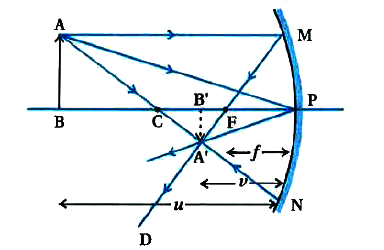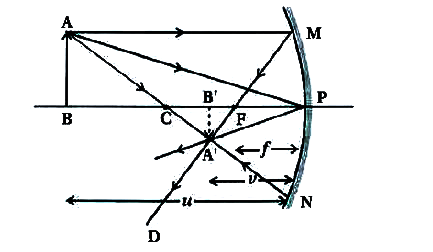Complete Solutions to SECTION-B (NUMERICALS)(NUMERICAL FROM TEXTUAL ILLUSTRATIONS) of chapter RAY OPTICS AND OPTICAL INSTRUMENTS of Class 12 book with complete answers and questions
| Class 12 | PHYSICS |
| Chapter | RAY OPTICS AND OPTICAL INSTRUMENTS |
| KUMAR PRAKASHAN | SECTION-B (NUMERICALS)(NUMERICAL FROM TEXTUAL ILLUSTRATIONS) |
| Number Of Questions | 17 |
| Academic Year | 2023-24 |
Suppose that the lower half of the concave mirror.s reflecting surface as shown in figure is covered with an opaque (non-reflective) material. What effect will this have on the image of an object placed in front of the mirror ?

View SolutionSuppose that the upper half of the concave mirror.s reflecting surface as shown in figure is covered with an opaque (non-reflective) material. What effect will this have on the image of an object placed in front of the mirror ?

View SolutionA mobile phone lies along the principal axis of a concave mirror, as shown in Fig. 9.7. Show by suitable diagram, the formation of its image. Explain why the magnification is not uniform. Will the distortion of image depend on the location of the phone with respect to the mirror?

View SolutionAs shown in the figure, a thin rod AB of length 10 cm is placed on the principal axis of a concave mirror such that it.s end B is at a distance of 40 cm from the mirror. If the focal length of the mirror is 20 cm, find the length of the image of the rod

View SolutionAn object is placed at (i) 10 cm, (ii) 5 cm in front of a concave mirror of radius of curvature 15 cm. Find the position, nature, and magnification of the image in each case.
View SolutionAn object is placed at 30 cm in front of a concave mirror of radius of curvature 30 cm. Find the position, nature, and magnification of the image in each case.
View SolutionSuppose while sitting in a parked car, you notice a jogger approaching towards you in the side view mirror of R = 2 m. If the jogger is running at a speed of 5 `ms^(-1)` , how fast the image of the jogger appear to move when the jogger is (a) 39 m, (b) 29 m, (c) 19 m, and (d) 9 m away.
View SolutionSuppose while sitting in a parked car, you notice a jogger approaching towards you in the side view mirror of R = 2 m. If the jogger is running at a speed of 5 `ms^(-1)`, how fast the image of the jogger appear to move when the jogger is (a) 49 m, (b) 59 m away.
View SolutionThe earth takes 24 h to rotate once about its axis. How much time does the sun take to shift by 1° when viewed from the earth?
View SolutionThe earth takes 24 h to rotate once about its axis. How much time does the sun take to shift by IS when viewed from the earth ?
View SolutionLight from a point source in air falls on a spherical glass surface (n = 1.5 and radius of curvature = 20 cm). The distance of the light source from the glass surface is 100 cm. At what position the image is formed?
View SolutionLight from a point source in air falls on a spherical glass surface (n = 1.5 and radius of curvature = 30 cm). The distance of the light source from the glass surface is 12 cm. At what position the image is formed
View SolutionA magician during a show makes a glass lens with n=1.47 disappear in the trough of liquid. What is the refractive index of the liquid.
View Solution(i) If f = 0.5 m for a glass lens, what is the power of the lens? (ii) The radii of curvature of the faces of a double convex lens are 10 cm and 15 cm. Its focal length is 12 cm. What is the refractive index of glass? (iii) A convex lens has 20 cm focal length in air. What is focal length in water? (Refractive index of air-water = 1.33, refractive index for air-glass = 1.5.)
View Solution(i) If f =- 0.2 m for a glass lens, what is the power ofthe lens?
(ii) The radii ofcurvature ofthe faces of a double convex lens are 15 cm and 12 cm. Its focal length is 15 cm. What is the refractive index of glass ?
(iii) Refractive index and radii of curvature oftwo equal plana-convex lens are 1.5 and 20 cm respectively. They are placed in a vessel such that their convex surfaces are in contact at centre and oil ofrefractive index 1.7 is filled in them, then what will be the focal length of combination ?
View SolutionFind the position of the image formed by the lens combination given in the Fig.

View SolutionDecide the position of the image formed by the given combination of lenses.

View Solution
SECTION-B (NUMERICALS)(NUMERICAL FROM TEXTUAL ILLUSTRATIONS) questions and complete solutions for chapter RAY OPTICS AND OPTICAL INSTRUMENTS of KUMAR PRAKASHAN KENDRA PHYSICS (GUJRATI ENGLISH) of Class 12
All Exercises from KUMAR PRAKASHAN Class 12 PHYSICS RAY OPTICS AND OPTICAL INSTRUMENTS
- SECTION - A (QUESTIONS - ANSWERS)
- SECTION - A (TRY YOURSELF)
- SECTION-B (NUMERICALS)(NUMERICAL FROM .DARPAN. BASED ON TEXTBOOK )
- SECTION-B (NUMERICALS)(NUMERICAL FROM TEXTUAL EXERCISE)
- SECTION-B (NUMERICALS)(NUMERICAL FROM TEXTUAL ILLUSTRATIONS)
- SECTION-C (NCERT EXEMPLAR SOLUTION) (LONG ANSWER TYPE QUESITONS)
- SECTION-C (NCERT EXEMPLAR SOLUTION) (MULTIPLE CHOICE QUESTIONS (MCQs))
- SECTION-C (NCERT EXEMPLAR SOLUTION) (SHORT ANSWER TYPE QUESITONS)
- SECTION-C (NCERT EXEMPLAR SOLUTION) (VERY SHORT ANSWER TYPE QUESITONS)
- SECTION-D (MULTIPLE CHOICE QUESTIONS (MCQs))(MCQs ASKED IN COMPETITIVE EXAMS)
- SECTION-D (MULTIPLE CHOICE QUESTIONS (MCQs))(MCQs FROM .DARPAN. BASED ON TEXTBOOK)
- SECTION-D (MULTIPLE CHOICE QUESTIONS (MCQs))(MCQs FROM .DARPAN. BASED ON TEXTBOOK)(MCQs BASED ON TEXTUAL ILLUSTRATION AND EXERCISE)
- SECTION-D (MULTIPLE CHOICE QUESTIONS (MCQs))(MCQs FROM .DARPAN. BASED ON TEXTBOOK)(NATURAL PHENOMENA DUE TO SUN LIGHT )
- SECTION-D (MULTIPLE CHOICE QUESTIONS (MCQs))(MCQs FROM .DARPAN. BASED ON TEXTBOOK)(OPTICAL INSTRUMENTS)
- SECTION-D (MULTIPLE CHOICE QUESTIONS (MCQs))(MCQs FROM .DARPAN. BASED ON TEXTBOOK)(REFRACTION AND DISPOSION BY PRISM)
- SECTION-D (MULTIPLE CHOICE QUESTIONS (MCQs))(MCQs FROM .DARPAN. BASED ON TEXTBOOK)(REFRACTION)
- SECTION-D (MULTIPLE CHOICE QUESTIONS (MCQs))(MCQs FROM .DARPAN. BASED ON TEXTBOOK)(REFRACTION, MAGNIFICATION, POWER AND COMBINATION OF LENS)
- SECTION-D (MULTIPLE CHOICE QUESTIONS (MCQs))(MCQs FROM .DARPAN. BASED ON TEXTBOOK)(TOTAL INTERNAL REFLECTION)